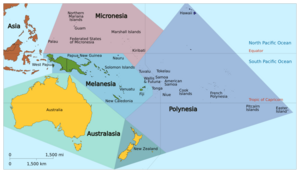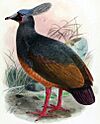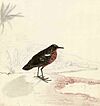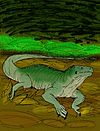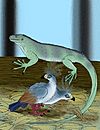List of Oceanian species extinct in the Holocene facts for kids
This is a list of Oceanian species extinct in the Holocene that covers extinctions from the Holocene epoch, a geologic epoch that began about 11,650 years before present (about 9700 BCE) and continues to the present day.
Oceania is a geographical region in the Pacific Ocean comprising Australasia, Melanesia, Micronesia, and Polynesia. Numerous species across Oceania became extinct as humans moved across the Pacific. Australia-New Guinea, New Zealand, and Hawaii have particularly large numbers of extinct species, so they listed in separate articles. Extinctions from the remaining Pacific Islands are listed below. This list includes sovereign states (such as Fiji) as well as island territories (such as French Polynesia). Extinctions from the associated states and dependent territory of New Zealand are listed below, and not with New Zealand proper. Papua New Guinea's Autonomous Region of Bougainville (part of the Solomon Islands archipelago) is included below, although the rest of Papua New Guinea is covered in List of Australia-New Guinea species extinct in the Holocene.
Many extinction dates are unknown due to a lack of relevant information.
Contents
- Mammals (class Mammalia)
- Birds (class Aves)
- Landfowl and relatives (clade Pangalliformes)
- Waterfowl (order Anseriformes)
- Nightjars (order Caprimulgiformes)
- Owlet-nightjars (order Aegotheliformes)
- Swifts, treeswifts, and hummingbirds (order Apodiformes)
- Pigeons and doves (order Columbiformes)
- Rails and cranes (order Gruiformes)
- Shorebirds (order Charadriiformes)
- Boobies, cormorants, and allies (order Suliformes)
- Pelicans, herons, and ibises (order Pelecaniformes)
- Hawks and relatives (order Accipitriformes)
- Owls (order Strigiformes)
- Kingfishers and relatives (order Coraciiformes)
- Parrots (order Psittaciformes)
- Perching birds (order Passeriformes)
- Reptiles (class Reptilia)
- Amphibians (class Amphibia)
- Insects (class Insecta)
- Snails and slugs (class Gastropoda)
- Plants (kingdom Plantae)
- See also
Mammals (class Mammalia)
Rodents (order Rodentia)
Old World rats and mice (family Muridae)
| Common name | Scientific name | Range | Comments |
|---|---|---|---|
| Buka Island mosaic-tailed rat | Melomys spechti | Buka Island, Autonomous Region of Bougainville | Most recent remains dated to 3050 BCE. |
| Buka Island solomys | Solomys spriggsarum |
Possibly extinct
| Common name | Scientific name | Range | Comments |
|---|---|---|---|
| Emperor rat | Uromys imperator | Aola, northern Guadalcanal, Solomon Islands | Not recorded with certainty since it was last collected in 1886-1888, though anecdotal information suggests the species survived until the 1960s. The causes of extinction are unknown. |
| Guadalcanal rat | Uromys porculus | Not recorded since it was last collected in 1886-1888. The causes of extinction are unknown. |
Bats (order Chiroptera)
Megabats (family Pteropodidae)
| Common name | Scientific name | Range | Comments |
|---|---|---|---|
| Nendo tube-nosed fruit bat | Nyctimene sanctacrucis | Nendö, Solomon Islands | Last recorded in 1907. |
| Small Samoan flying fox | Pteropus allenorum | Upolu, Samoa | Only known from the holotype collected in 1856. |
| Large Samoan flying fox | Pteropus coxi | Samoa | Known from two individuals collected in 1839-1841. The exact island of origin is unknown because it was not recorded, but unconfirmed sightings happened until the 1980s. |
| Large Palau flying fox | Pteropus pilosus | Palau | Known from two individuals collected before 1874. The causes of extinction are unknown. |
| Guam flying fox | Pteropus tokudae | Guam | Last known individual was killed in 1968, with an unconfirmed sighting happening in the late 1970s. It was probably hunted to extinction, though the introduced brown tree snake could have contributed. |
Possibly extinct
| Common name | Scientific name | Range | Comments |
|---|---|---|---|
| Montane monkey-faced bat | Pteralopex pulchra | Mount Makarakomburu, Guadalcanal, Solomon Islands | Only known from the holotype collected in 1991. The causes of extinction are unknown. |
Vesper bats (family Vespertilionidae)
| Common name | Scientific name | Range | Comments |
|---|---|---|---|
| Insular myotis | Myotis insularum | Samoa | Last recorded in the 1860s. |
Birds (class Aves)
Landfowl and relatives (clade Pangalliformes)
Sylviornithids (family Sylviornithidae)
| Scientific name | Range | Comments | Images |
|---|---|---|---|
| Megavitiornis altirostris | Fiji | Most recent remains at the Naigani Lapita culture site dated to 950 BCE. Flightless and totally terrestrial, it would have been quickly exterminated by humans and introduced mammals. | |
| Sylviornis neocaledoniae | Grande Terre and Isle of Pines, New Caledonia | Most recent remains at the Pindai Caves dated to 1120-840 BCE. The species was flightless and laid a single egg uncovered on the ground, which wasn't incubated. This made it easy prey for introduced predators. |  |
Megapodes (family Megapodidae)
| Common name | Scientific name | Range | Comments |
|---|---|---|---|
| Consumed scrubfowl | Megapodius alimentum | Tonga and Fiji | Dated in Fiji around 850 BCE and in Tongoleleka, Lifuka Island to 840-740 BCE. It retained the ability to fly despite being almost as large as New Caledonia's pile-builder megapode. Nevertheless, it went extinct a couple of centuries after human settlement as a result of hunting, egg harvesting, and predation by introduced animals. |
| Viti Levu scrubfowl | Megapodius amissus | Aiwa Levu, Fiji | Likely flightless unlike other small megapodes, which would make it vulnerable to introduced predators. |
| Pile-builder megapode | Megapodius molistructor | New Caledonia | Most recent remains at the Pindai Caves dated to 86-428 CE. It was the largest species of its genus and almost certainly hunted to extinction by humans. Megapodius andersoni, a hypothetical species named from a brief description written by William Anderson during the third voyage of James Cook (1776-1780), may or may not be the same animal. Remains provisionally assigned to this species in Tonga are different enough to represent another species, or even genus. |
| Megapodius sp. | Tonga | A large megapode similar to M. molistructor of New Caledonia, but likely a different species or even genus. Lived alongside, but was rarer than the smaller M. alimentum. | |
| Large Solomon Islands megapode | Megapodius sp. | Buka Island, Autonomous Region of Bougainville | Prehistoric |
| Lini's megapode | Mwalau walterlinii | Efate, Vanuatu | Described from remains found in Lapita culture levels dating to 1050-850 BCE. It could fly despite being larger than any extant megapode. |
Locally extinct
| Common name | Scientific name | Range | Comments | Pictures |
|---|---|---|---|---|
| Dusky megapode | Megapodius freycinet | From the Maluku Islands to Tonga | Currently only present from the Maluku Islands to the Bird's Head Peninsula in New Guinea. It survived in Tikopia, Solomon Islands until the Lapita period. |  |
Pheasants and allies (family Phasianidae)
Locally extinct
| Common name | Scientific name | Range | Comments | Pictures |
|---|---|---|---|---|
| Stubble quail | Coturnix pectoralis | Australia and New Caledonia | Extirpated from New Caledonia after human settlement. |  |
Waterfowl (order Anseriformes)
Ducks, geese, and swans (family Anatidae)
| Common name | Scientific name | Range | Comments | Pictures |
|---|---|---|---|---|
| Rennell Island teal | Anas gibberifrons remissa | Rennell, Solomon Islands | Restricted to a single lagoon in the island, it disappeared in 1959 after Tilapia fish was introduced and presumably destroyed its food supply. | |
| Mariana mallard | Anas platyrhynchos oustaleti | Guam, Tinian, and Saipan, Mariana Islands | A captive breeding program intended to save it from extinction ended in failure with the death of the last individual (pictured) in 1981. |  |
| Coues's gadwall | Mareca strepera couesi | Teraina, Line Islands, Kiribati | A sedentary subspecies likely descended from stranded birds. It was never seen alive again after its discovery in 1874. |  |
| Rota flightless duck | Anatidae incertae sedis | Rota, Mariana Islands | Described from a subfossil juvenile coracoid. |
Nightjars (order Caprimulgiformes)
Typical nightjars (family Caprimulgidae)
Possibly extinct
| Common name | Scientific name | Range | Comments |
|---|---|---|---|
| New Caledonian nightjar | Eurostopodus exul | Northwestern New Caledonia | Known only from the type specimen collected in 1939. |
Owlet-nightjars (order Aegotheliformes)
Owlet-nightjars (family Aegothelidae)
Possibly extinct
| Common name | Scientific name | Range | Comments | Pictures |
|---|---|---|---|---|
| New Caledonian owlet-nightjar | Aegotheles savesi | Southwestern New Caledonia | Last known individual was shot in 1960, and an unconfirmed sighting and calls were recorded in 1998. Like other owlet-nightjars, it could have declined due to predation by introduced cats and rats, and habitat loss through fire, mining, and logging. |  |
Swifts, treeswifts, and hummingbirds (order Apodiformes)
Swifts (family Apodidae)
| Common name | Scientific name | Range | Comments |
|---|---|---|---|
| Mangaia swiftlet | Aerodramus manuoi | Mangaia, Cook Islands | Known from Holocene remains. |
Pigeons and doves (order Columbiformes)
Pigeons and doves (family Columbidae)
| Common name | Scientific name | Range | Comments | Pictures |
|---|---|---|---|---|
| Henderson archaic pigeon | Bountyphaps obsoleta | Henderson Island, Pitcairn | Most recent remains from Polynesian middens dated to 1000-1600 CE. It was the largest of four pigeon species originally present in the island, and a poor flier but not flightless. It was likely hunted to extinction. | |
| Kanaka pigeon | Caloenas canacorum | New Caledonia; possibly Vanuatu and Fiji | Most recent remains at the Pindai Caves dated to 86-428 CE. It was likely hunted to extinction. Remains provisionally assigned to this taxon in Tonga likely belong to a different species. | |
| Caloenas sp. | Tonga | Known from subfossil remains. | ||
| Spotted green pigeon | Caloenas maculata | unknown, possibly Tahiti, French Polynesia | Known from two specimens of unknown origin that were collected in 1783 and 1823, believed to have come from somewhere in the Pacific Ocean. Its coloration suggests that it was a forest-dweller, and its short and rounded wings that it evolved in a predator-free island. 1928 native accounts of a bird in Tahiti may refer to this species. It could have disappeared due to hunting or introduced predators before extensive European exploration of the Pacific. |  |
| Tongan tooth-billed pigeon | Didunculus placopedetes | Tonga | Most recent remains dated to 900-750 BCE. | |
| David's imperial pigeon | Ducula david | Ouvéa Island, New Caledonia | Most recent remains at Utuleve dated to 550-50 BCE. | |
| Henderson imperial pigeon | Ducula harrisoni | Henderson Island, Pitcairn | Most recent remains dated to 1000-1600 CE. | |
| Lakeba pigeon | Ducula lakeba | Lakeba and Aiwa Levu, Fiji | Most recent remains dated to around 850 BCE. | |
| Ducula shutleri | Tonga | Known from subfossil remains dated to 855-730 BCE. | ||
| Rota large ground dove | Gallicolumba sp. | Rota, Mariana Islands | Known from subfossil remains. Coexisted with the smaller Micronesian pigeon, now extirpated from the Marianas. | |
| Huahine cuckoo-dove | Macropygia arevarevauupa | Huahine, Society Islands, French Polynesia | Most recent remains at Fa'ahia dated to 700-1150 CE. | |
| Marquesas cuckoo-dove | Macropygia heana | Nuku Hiva and Ua Huka, Marquesa Islands | Most recent remains at Hane, Ua Huka dated to 300-1200 CE. | |
| Choiseul pigeon | Microgoura meeki | Choiseul, and speculatively Bougainville and Malaita, Solomon Islands | Not recorded since 1904; more recent observations are believed to be confusions with other doves and pigeons. It was probably exterminated by introduced dogs and cats. | |
| Viti Levu giant pigeon | Natunaornis gigoura | Viti Levu, Fiji | Known from subfossil remains. It was the third largest pigeon ever after the dodo and Rodrigues solitaire, flightless and adapted to eat large fruit, seeds, and insects on the ground. Like the former, it would have been extremely vulnerable to hunting and introduced mammals predating on its eggs and chicks. |  |
| Mangaia ground dove | Pampusana erythroptera ssp. | Mangaia, Cook Islands | Known from subfossil remains. | |
| Society Islands ground dove | Pampusana erythroptera ssps. | Moorea and Tahiti, French Polynesia | Known from a few specimens collected between 1768 and 1779 (mostly lost), paintings and descriptions. Differences in the paintings suggest that they represent two undescribed subspecies. Two other subspecies were described in the Tuamotu Islands, where at least one survives. | |
| Tanna ground dove | Pampusana ferruginea | Tanna Island, Vanuatu | Only known from a 1774 painting by Georg Forster. |  |
| Henderson ground dove | Pampusana leonpascoi | Henderson Island, Pitcairn | Most recent remains dated to 1000-1600 CE. | |
| New Caledonian ground dove | Pampusana longitarsus | New Caledonia | Most recent remains at the Pindai Caves dated to 86-428. | |
| Great ground dove | Pampusana nui | Marquesas, Cook, Society, and Tuamotu Islands | Most recent remains in Mangaia dated to 1390-1470 CE. | |
| Thick-billed ground dove | Pampusana salamonis | Makira and Ramos, Solomon Islands | Known from one individual collected in Makira in 1882 and another from Ramos in 1927. Likely declined due to hunting, predation by introduced rats and cats, and habitat destruction. | |
| Red-moustached fruit dove | Ptilinopus mercierii | Nuku Hiva and Hiva Oa, Marquesa Islands, French Polynesia | Only recorded in Nuku Hiva when the holotype was collected in 1836-1839, and last recorded in Hiva Oa in 1922. A record from 1980 was mistaken. Disappeared due to predation by introduced great horned owls, cats, and rats. |  |
| Mauke fruit dove | Ptilinopus rarotongensis byronensis | Mauke, Cook Islands | Only known from a 1825 description by Andrew Bloxam. |
Possibly extinct
| Common name | Scientific name | Range | Comments | Pictures |
|---|---|---|---|---|
| White-headed Polynesian ground dove | Pampusana erythroptera albicollis | Hao, Hiti, and possibly Tahanea, French Polynesia | Last sighted in the 1950s. Disappeared due to predation by introduced cats and rats. |
Locally extinct
| Common name | Scientific name | Range | Comments | Pictures |
|---|---|---|---|---|
| Tongan ground dove | Pampusana stairi | From Wallis and Futuna to New Caledonia | Extirpated from New Caledonia after human settlement. |  |
Rails and cranes (order Gruiformes)
Rails (family Rallidae)
| Common name | Scientific name | Range | Comments | Pictures |
|---|---|---|---|---|
| Nuku Hiva rail | Hypotaenidia epulare | Nuku Hiva, Marquesas Islands | Most recent remains dated to around 950 CE. The remains were found in middens along with other vertebrate bones and shells of animals consumed by Polynesians. It was probably hunted to extinction. | |
| Ua Huka rail | Hypotaenidia gracilitibia | Ua Huka, Marquesas Islands | Most recent remains dated to around 600 CE. | |
| Niue rail | Hypotaenidia huiatua | Niue | Known from subfossil remains predating human settlement, but believed to have been driven to extinction by hunting or anthropogenic changes to its environment. | |
| Tongatapu rail | Hypotaenidia hypoleucus | Tongatapu, Tonga | Known from John Latham's 1785 description of birds collected by William Anderson during the third voyage of James Cook (1776-1780). The species was likely exterminated by feral dogs introduced by Cook's previous visit in 1773. |  |
| Tahiti rail | Hypotaenidia pacifica | Tahiti and Mehetia, Society Islands, French Polynesia | Last reported in Tahiti in 1844 and in Mehetia in the 1930s. It was flightless. Its extinction was presumably caused by introduced cats and rats. | 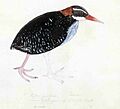 |
| Tinian rail | Hypotaenidia pendiculentus | Tinian, Mariana Islands | Known from subfossil remains. | |
| Aguiguan rail | Hypotaenidia pisonii | Aguiguan, Mariana Islands | Known from subfossil remains, nearly all of which show charring from cooking fires. | |
| Bar-winged rail | Hypotaenidia poeciloptera | Viti Levu and Ovalau, Fiji | Last seen with certainty before 1890. There were unconfirmed sightings in Taveuni in 1971, and in Waisa, Viti Levu in 1973. It was possibly exterminated by introduced cats and mongooses. |  |
| Mangaia rail | Hypotaenidia ripleyi | Mangaia, Cook Islands | Known from subfossil remains. Likely extinct due to hunting, habitat alteration, and introduction of mammalian predators. | |
| Tahuata rail | Hypotaenidia roletti | Tahuata, Marquesas Islands | Most recent remains dated to around 950 CE. One of only two known rails from eastern Polynesia, it was likely flightless and had robust legs adapted to a terrestrial lifestyle. As a result, it would have been extremely vulnerable to humans and introduced predators. | |
| Tabuai rail | Hypotaenidia steadmani | Tabuai, Austral Islands, French Polynesia | Known from subfossil remains. It possibly disappeared around 1300 CE, soon after the arrival of Polynesians. | |
| Huahine rail | Hypotaenidia storrsolsoni | Huahine, Society Islands, French Polynesia | Most recent remains at Fa'ahia dated to 700-1150 CE. Its remains were found in Polynesian middens, and it likely disappeared due to hunting or predation by introduced mammals. | |
| Rota rail | Hypotaenidia temptatus | Rota, Mariana Islands | Known from subfossil remains. | |
| Vava'u rail | Hypotaenidia vavauensis | Vava'u, Tonga | Depicted alive by the Malaspina Expedition in 1793. Its existence was confirmed with the finding of Lapita culture remains in 2004-2014. |  |
| Eua rail | Hypotaenidia vekamatolu | ʻEua, Tonga | Known from subfossil remains. It disappeared between the arrival of Polynesians around 1300 and Europeans in 1800. | |
| Wake Island rail | Hypotaenidia wakensis | Wake and Wilkes Island | Likely hunted to extinction by besieged Japanese Empire troops during the World War II occupation of Wake Island. | 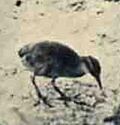 |
| Hiva Oa rail | Hypotaenidia sp. | Hiva Oa, Marquesas Islands | One of only two rail species from eastern Polynesia. It was flightless. | |
| New Caledonian gallinule | Porphyrio kukwiedei | New Caledonia | Most recent remains at the Pindai Caves dated to 86-428 CE. A possible native name, n'dino, was recorded in 1860. | |
| Huahine swamphen | Porphyrio mcnabi | Huahine, Society Islands, French Polynesia | Most recent remains at Fa'ahia dated to 700-1150 CE. | |
| Marquesas swamphen | Porphyrio paepae | Hiva Oa and Tahuata, Marquesas Islands, French Polynesia | Though described from subfossil remains, it could have survived until the 20th century on account of a gallinule depicted being hunted by a dog on the 1902 painting Le Sorcier d'Hiva Oa, by Paul Gauguin. Thor Heyerdahl also observed a similar bird in 1937. |  |
| Rota swamphen | Porphyrio sp. | Rota, Mariana Islands | Known from subfossil remains. | |
| Viti Levu rail | Vitirallus watlingi | Viti Levu, Fiji | Known from subfossil remains. It was apparently restricted to lowlands, which would be more susceptible to fires. Likely disappeared due to hunting, habitat destruction, and predation by introduced mammals like the Polynesian rat. | |
| Kosrae crake | Zapornia monasa | Kosrae, Micronesia | Known from two individuals collected in 1827-1828. Considered sacred by the natives and not hunted, it likely disappeared due to predation by rats, which were plentiful by the time ornithologists fruitlessly searched for the bird again, in 1880. | |
| Tahiti crake | Zapornia nigra | Tahiti, Society Islands, and possibly Mangaia, Cook Islands | Depicted by Georg Forster during Cook's second voyage (1772-1775); John Frederick Miller's more famous painting from 1784 is a copy. It disappeared soon after from Tahiti but it or a similar species (different from Zapornia rua) could have survived in Mangaia until recently. |  |
| Mangaia crake | Zapornia rua | Mangaia, Cook Islands | Known from subfossil remains. | |
| Easter Island crake | Zapornia sp. | Easter Island, Chile | Disappeared between 1000 and 1430 CE. | |
| Buka swamphen | Porphyrio sp. | Buka Island, Autonomous Region of Bougainville | Prehistoric | |
| Easter Island rail | Rallidae incertae sedis | Easter Island, Chile | Disappeared between 1000 and 1430 CE. | |
| Rallidae incertae sedis | Tonga | A species of size intermediate between H. vavauensis and H. philippensis, dated to 855-730 BCE. |
Possibly extinct
| Common name | Scientific name | Range | Comments | Pictures |
|---|---|---|---|---|
| New Caledonian rail | Gallirallus lafresnayanus | New Caledonia | Not seen with certainty since 1890 and likely extirpated by predation from introduced rats, cats, and pigs. However, unconfirmed sightings in the 1960s and 1984 may hint to its survival in montane forests inaccessible to such predators. |  |
| Samoan wood rail | Pareudiastes pacificus | Savai'i, Samoa | Last seen in 1873 and likely extirpated by hunting and predation by introduced rats, cats, dogs, and pigs. | |
| Makira woodhen | Pareudiastes silvestris | Makira, Solomon Islands | Known from the type collected in 1929 and a single confirmed observation in 1953. It likely declined due to introduced predators like cats, dogs, and electric ants. |
Extinct in the wild
| Common name | Scientific name | Range | Comments | Pictures |
|---|---|---|---|---|
| Guam rail | Hypotaenidia owstoni | Guam | Extirpated from the wild in 1987, as a result of predation by introduced brown tree snakes. Following a captive breeding program, it was reintroduced to the smaller offshore islands of Rota and Cocos in 2010, but only the Cocos population is self-sustaining. |  |
Locally extinct
| Common name | Scientific name | Range | Comments | Pictures |
|---|---|---|---|---|
| Lewin's rail | Lewinia pectoralis | Australia, Wallacea, New Guinea, and New Caledonia | Extirpated from New Caledonia after human settlement. |  |
Shorebirds (order Charadriiformes)
Sandpipers (family Scolopacidae)
| Common name | Scientific name | Range | Comments | Pictures |
|---|---|---|---|---|
| Viti Levu snipe | Coenocorypha miratropica | Viti Levu, Fiji | Known from subfossil remains. Probably disappeared due to predation by introduced pigs, dogs, and Polynesian rats. | |
| New Caledonian snipe | Coenocorypha neocaledonica | New Caledonia | Known from two subfossil humeri and a coracoid. Probably driven to extinction by introduced rats. | |
| Christmas sandpiper | Prosobonia cancellata | Kiritimati, Kiribati | Only known from the type, collected in 1778 and subsequently lost. It was probably exterminated by invasive cats. | 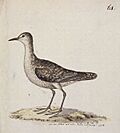 |
| Moorea sandpiper | Prosobonia ellisi | Moorea, Society Islands, French Polynesia | Only known from two paintings based on individuals collected during Cook's third voyage in 1777, and subsequently lost. Some authors suggest it was the same species as the Tahiti sandpiper, while others defend its specific status on plumage differences. In the absence of specimens, the species must be considered dubious. It was probably exterminated by invasive mammals, though habitat destruction could have been another factor. |  |
| Tahiti sandpiper | Prosobonia leucoptera | Tahiti, Society Islands, French Polynesia | Known from an individual collected during Cook's voyage in 1773. It could have been driven to extinction by habitat destruction caused by invasive pigs and goats, or predation by rats. |
Gulls, terns, and skimmers (family Laridae)
| Common name | Scientific name | Range | Comments |
|---|---|---|---|
| Huahine gull | Chroicocephalus utunui | Huahine, Society Islands, French Polynesia | Most recent remains dated to 700-1150 CE. It could have disappeared due to hunting, habitat loss, disease, or predation from introduced mammals. |
Buttonquails (family Turnicidae)
| Common name | Scientific name | Range | Comments |
|---|---|---|---|
| New Caledonian buttonquail | Turnix varius novaecaledoniae | New Caledonia | Known only from the type specimen collected in 1889 and subfossil remains. Studies of owl pellets are consistent with the subspecies (or species) gradually declining over time and becoming extinct shortly after it was described. Deforestation through burning and introduced mammals could have contributed to its extinction. |
Boobies, cormorants, and allies (order Suliformes)
Boobies and gannets (family Sulidae)
| Common name | Scientific name | Range | Comments |
|---|---|---|---|
| Ua Huka booby | Papasula abbotti costelloi | Ua Huka and Tahuata, Marquesas Islands | Only known from subfossil remains at archaeological middens, indicating that it was regularly hunted by Polynesians before its extinction around 1200 CE. It was larger than Abbott's booby and may be a different species. It probably nested only in tall trees, like Abbott's booby, which would also make it vulnerable to habitat destruction. |
Locally extinct
| Common name | Scientific name | Range | Comments | Pictures |
|---|---|---|---|---|
| Abbott's booby | Papasula abbotti abbotti | Indian Ocean to Micronesia and Melanesia | Only found in the present on Christmas Island, an Australian dependency southwest of Indonesia. Subfossil remains are known from Tikopia, Solomon Islands and Efate, Vanuatu. A vagrant female was photographed in Rota, Northern Mariana Islands in 2007. | 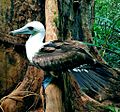 |
Pelicans, herons, and ibises (order Pelecaniformes)
Herons (family Ardeidae)
| Common name | Scientific name | Range | Comments |
|---|---|---|---|
| Easter Island heron | cf. Egretta sp. | Easter Island, Chile | Disappeared around 1000-1430 CE. |
| Niue night heron | Nycticorax kalavikai | Niue | Most recent remains at Anakuli Cave dated to 2550-1550 BCE. It likely disappeared due to hunting and predation by introduced mammals. |
| Nycticorax sp. | Tonga | Known from subfossil remains. |
Hawks and relatives (order Accipitriformes)
Hawks, eagles, kites, harriers and Old World vultures (family Accipitridae)
| Common name | Scientific name | Range | Comments |
|---|---|---|---|
| Powerful goshawk | Accipiter efficax | New Caledonia | Two species most recently dated to 86-428 CE at the Pindai Caves. The reason of extinction is unknown, as New Caledonia is today home to two other Accipiter species, the brown goshawk and the white-bellied goshawk. However, the extinct and extant species not being found together could indicate that they lived in different habitats, or that the extant species colonized the island after the others disappeared. |
| Gracile goshawk | Accipiter quartus | ||
| Vanuatu hawk | Accipiter sp. | Vanuatu | Known from subfossil remains. Became extinct after the arrival of the Lapita peoples. |
Owls (order Strigiformes)
True owls (family Strigidae)
Locally extinct
| Common name | Scientific name | Range | Comments | Images |
|---|---|---|---|---|
| Morepork | Ninox novaeseelandiae | New Caledonia, Lord Howe Island, Norfolk Island, and New Zealand | Extirpated from New Caledonia after human settlement. |  |
Barn-owls (family Tytonidae)
| Common name | Scientific name | Range | Comments |
|---|---|---|---|
| New Caledonian barn owl | Tyto letocarti | New Caledonia | Almost entirely dependent on reptiles, it became extinct when reptile numbers crashed after the colonization of New Caledonia by humans and the Polynesian rat. The island was later colonized by the common barn owl (T. alba), whose diet is rodent-based. |
Kingfishers and relatives (order Coraciiformes)
Kingfishers (family Alcedinidae)
Extinct in the wild
| Common name | Scientific name | Range | Comments | Pictures |
|---|---|---|---|---|
| Guam kingfisher | Todiramphus cinnamominus | Guam | Following catastrophic predation by the introduced brown tree snake, the last 29 individuals were caught in 1986 and taken to the United States, where there are over a hundred now in captivity. | 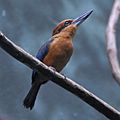 |
Parrots (order Psittaciformes)
Old World parrots (family Psittaculidae)
| Common name | Scientific name | Range | Comments | Pictures |
|---|---|---|---|---|
| Raiatea parakeet | Cyanoramphus ulietanus | Raiatea, Society Islands, French Polynesia | Known from two individuals generally believed to have been collected during Cook's second voyage in 1773 or 1774, though 1777 during the third voyage is also possible. | |
| Black-fronted parakeet | Cyanoramphus zealandicus | Tahiti, Society Islands, French Polynesia | Last collected in 1844. It could have become extinct due to habitat loss, hunting, or predation by introduced species. | |
| Oceanic eclectus | Eclectus infectus | 'Eua, Lifuka, Uiha, and Vava'u in Tonga; possibly also Vanuatu and Fiji | Described from subfossil remains. A live bird from Vava'u was likely depicted by members of the Malaspina Expedition in 1793. It presumably became extinct soon after due to hunting and predation by introduced mammals. | 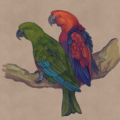 |
| Sinoto's lorikeet | Vini sinotoi | Marquesas and Society Islands | Most recent remains dated to 810-1025 CE. It could have become extinct due to predation by Polynesian rats. | |
| Conquered lorikeet | Vini vidivici | Marquesas, Society, and Cook Islands | Most recent remains dated to 1000-1200 CE. It could have become extinct due to predation by Polynesian rats. |  |
| Easter Island parrots | Psittaciformes incertae sedis | Easter Island, Chile | Two species extinct between 1000 and 1430 CE. |
Possibly extinct
| Common name | Scientific name | Range | Comments | Pictures |
|---|---|---|---|---|
| New Caledonian lorikeet | Charmosyna diadema | New Caledonia | Known from two individuals collected before 1860. It was reported as existing in Oubatche in 1913, and an unconfirmed sighting southwest of Mount Panié was made in 1976. |  |
Perching birds (order Passeriformes)
Pittas (family Pittidae)
| Common name | Scientific name | Range | Comments | Pictures |
|---|---|---|---|---|
| Bougainville black-faced pitta | Pitta anerythra pallida | Bougainville Island, Autonomous Region of Bougainville | Last recorded in 1938. | 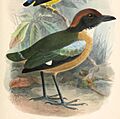 |
Fantails and silktails (family Rhipiduridae)
| Common name | Scientific name | Range | Comments | Pictures |
|---|---|---|---|---|
| Guam rufous fantail | Rhipidura rufifrons uraniae | Guam | Last recorded in either 1984 or 1985. Extinct primarily because of predation by introduced brown tree snakes, assisted by rats, monitor lizards, and possibly residual pesticides. |  |
Reed warblers (family Acrocephalidae)
| Common name | Scientific name | Range | Comments | Pictures |
|---|---|---|---|---|
| Mangareva reed warbler | Acrocephalus astrolabii | unknown; possibly the Gambier Islands, French Polynesia | Known only from two individuals collected by Jules Dumont d'Urville in either 1826-1829 or 1838-1839. Likely disappeared due to deforestation and introduced predators. | |
| Moorea reed warbler | Acrocephalus longirostris | Moorea, Society Islands, French Polynesia | Last recorded in 1973; a later reported observation is unconfirmed. It probably disappeared due to severe deforestation, predation by introduced mammals, or avian malaria which was introduced to the island in the 1970s. | |
| Nightingale reed warbler | Acrocephalus luscinius | Guam | Last recorded in 1969. It was driven to extinction by the introduced predatory brown tree snake. Habitat loss caused by fire and drainage of wetlands, pesticide use, and additional introduced predators like cats and rats were also contributing factors. | 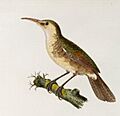 |
| Huahine warbler | Acrocephalus musae garretti | Huahine, Society Islands, French Polynesia | Only known from five individuals collected around 1869. It likely became extinct due to predation by introduced rats. | |
| Raiatea warbler | Acrocephalus musae musae | Raiatea, Society Islands, French Polynesia | Last collected between 1870 and 1873. | |
| Aguijan reed warbler | Acrocephalus nijoi | Aguiguan, Mariana Islands | Last recorded in the mid-1990s. Extinct due to habitat loss caused by deforestation and grazing by introduced goats. | |
| Pagan reed warbler | Acrocephalus yamashinae | Pagan, Mariana Islands | Last recorded in the 1970s. It was made extinct by draining its wetland habitat for agriculture, grazing feral livestock destroying the understorey, which it used to breed, predation by introduced cats and rats, and general increase in land use by the military. If still alive in 1981, it might have been wiped out by a volcanic eruption that destroyed much of the remaining woody vegetation. |
Grassbirds and allies (family Locustellidae)
Possibly extinct
| Common name | Scientific name | Range | Comments |
|---|---|---|---|
| Vanua Levu long-legged thicketbird | Cincloramphus rufus cluniei | Vanua Levu, Fiji | Only known from the type specimen collected in 1974. An unconfirmed sighting was made in 1990. |
White-eyes (family Zosteropidae)
| Common name | Scientific name | Range | Comments | Pictures |
|---|---|---|---|---|
| Guam bridled white-eye | Zosterops conspicillatus conspicillatus | Guam | Last recorded in 1983. Disappeared due to predation by the introduced brown tree snake. |  |
Starlings (family Sturnidae)
| Common name | Scientific name | Range | Comments | Pictures |
|---|---|---|---|---|
| Kosrae starling | Aplonis corvina | Kosrae, Micronesia | Last collected in 1828. It disappeared due to predation by introduced rats. |  |
| Huahine starling | Aplonis diluvialis | Huahine, Society Islands, French Polynesia | Most recent remains at Fa'ahia dated to 700-1150 CE. | |
| Mysterious starling | Aplonis mavornata | Mauke, Cook Islands | Only known from the type specimen collected in 1825. It disappeared due to predation by introduced rats. | |
| Raiatea starling | Aplonis ulietensis | Raiatea, Society Islands, French Polynesia | Known from a 1774 painting and descriptions. It is presumed to have been driven to extinction by introduced rats. | |
| Erromango starling | Aplonis sp. | Erromango, Vanuatu | Last dated in Ponamia after 950 BCE. |
Possibly extinct
| Common name | Scientific name | Range | Comments | Pictures |
|---|---|---|---|---|
| Pohnpei starling | Aplonis pelzelni | Pohnpei, Micronesia | Last collected in 1995, with unconfirmed sightings in 2008. The reasons for its decline, which began in the 1930s, is unknown. Habitat loss, hunting, and predation by introduced rats have been suggested. |  |
Monarch flycatchers (family Monarchidae)
| Common name | Scientific name | Range | Comments | Pictures |
|---|---|---|---|---|
| Guam flycatcher | Myiagra freycineti | Guam | Once common through the island, its population crashed rapidly after brown tree snakes were introduced, becoming restricted to the northern plateau in 1971, then to the Pajon Basin in early 1983. By the time a captive breeding program was set up in October of the same year, only one male could be found and captured. This animal died in captivity in May 1984 of unknown causes. Introduced diseases could also have contributed to its extinction. |  |
| Myiagra sp. | Ua Huka, Marquesas Islands, French Polynesia | Known from subfossil remains. | ||
| Eiao monarch | Pomarea fluxa | Eiao, Marquesas Islands, French Polynesia | Last recorded in 1977. Disappeared soon after the chestnut-breasted mannikin was introduced to the island, implying that a exotic avian disease was transmitted to the population. The species may have also declined earlier due to habitat loss caused by sheep grazing, and predation by feral cats, black rats, and Polynesian rats. | |
| Nuku Hiva monarch | Pomarea nukuhivae | Nuku Hiva, Marquesas Islands, French Polynesia | Last recorded in the 1930s. Declined due to habitat loss caused by intense grazing and fire, and predation by introduced species including the black rat. | |
| Maupiti monarch | Pomarea pomarea | Maupiti, Society Islands, French Polynesia | Known only from the type specimen, collected in 1823. It was likely driven extinct by introduced species. |  |
Possibly extinct
| Common name | Scientific name | Range | Comments |
|---|---|---|---|
| Ua Pou monarch | Pomarea mira | Ua Pou, Marquesas Islands, French Polynesia | Last confirmed record in 1985, with an unconfirmed sighting in 2010. It likely declined due to habitat loss and degradation through overgrazing and fires, along with predation by introduced mammals. |
Reptiles (class Reptilia)
Crocodilians (order Crocodilia)
Mekosuchines (clade Mekosuchinae)
| Scientific name | Range | Comments | Pictures |
|---|---|---|---|
| Mekosuchus inexpectatus | Grande Terre and Isle of Pines, New Caledonia | Possibly survived until 140-280 CE, although this datation was not made directly on Mekosuchus bones. | |
| Mekosuchus kalpokasi | Efate, Vanuatu | Known from subfossil remains dated to around 1050 BCE. | |
| Volia athollandersoni | Fiji | Most recent remains at Naigani dated to 950 BCE. |
Squamates (order Squamata)
Australia-New Zealand geckos (family Diplodactylidae)
| Common name | Scientific name | Range | Comments | Pictures |
|---|---|---|---|---|
| Delcourt's giant gecko | Gigarcanum delcourti | unknown; probably New Caledonia | Only known from a unlabelled, stuffed specimen discovered in the collections of the Natural History Museum of Marseille in 1986. The provenance and date of collection are unknown, but it is estimated to have been deposited in the 1830s on the style of preservation. The species was originally assigned to the New Zealand genus Hoplodactylus and speculated to be the inspiration of the kawekaweau of Maori folklore, but a genetic phylogeny in 2023 placed it among New Caledonian geckos instead. |  |
Skinks (family Scincidae)
| Common name | Scientific name | Range | Comments |
|---|---|---|---|
| Tonga ground skink | Tachygia microlepis | Tonga | Only known specimens collected by Dumont d'Urville during the Astrolabe expedition, which returned to France in 1829. |
Iguanas and chuckwallas (family Iguanidae)
Monitor lizards (family Varanidae)
| Common name | Scientific name | Range | Comments |
|---|---|---|---|
| New Caledonian goanna | Varanus sp. | New Caledonia | Present before human settlement and presumed extinct for anthropogenic causes, though the evidence of interaction with humans is lacking. |
Turtles and tortoises (order Testudines)
Horned turtles (family Meiolaniidae)
| Common name | Scientific name | Range | Comments | Pictures |
|---|---|---|---|---|
| Vanuatu horned turtle | Meiolania damelipi | Vanuatu and Viti Levu, Fiji | Hunted to extinction by about 810 BCE. | |
| New Caledonia horned turtle | Meiolania mackayi | New Caledonia | Extinct around 531 CE. |  |
Amphibians (class Amphibia)
Frogs (order Anura)
Wrinkled ground frogs (family Ceratobatrachidae)
| Common name | Scientific name | Range | Comments |
|---|---|---|---|
| Giant Fiji ground frog | Platymantis megabotoniviti | Viti Levu, Fiji | Became extinct after humans arrived on Fiji with the commensal Polynesian rat and large New Guinea spiny rat during the first millennium BCE. Unlike other platymantine frogs that survived, it was a fully terrestrial species that didn't climb trees nor live near water. It probably also had relatively large eggs and juveniles, like its relatives, all of which would make this species more vulnerable to introduced predators. |
Insects (class Insecta)
Beetles (order Coleoptera)
Predaceous diving beetles (family Dytiscidae)
| Scientific name | Range |
|---|---|
| Rhantus novacaledoniae | New Caledonia |
Moths and butterflies (order Lepidoptera)
Smoky moths (family Zygaenidae)
| Common name | Scientific name | Range | Comments | Pictures |
|---|---|---|---|---|
| Levuana moth | Levuana iridescens | Viti Levu, Fiji | Last recorded in 1956. The extinction followed the introduction of the parasitic fly Bessa remota by coconut farmers, as a form of biological pest control. However, it's been argued that L. iridescens was not actually native to Fiji and that lack of post-1956 records is the result of diminished enthomological research after Fiji's independence. |  |
Snails and slugs (class Gastropoda)
Order Stylommatophora
Family Bothriembryontidae
| Scientific name | Range | Comments | Pictures |
|---|---|---|---|
| Leucocharis loyaltiensis | New Caledonia | Last recorded in the 1900s. | |
| Leucocharis porphyrocheila | New Caledonia | Last recorded in the 1900s. |  |
Family Charopidae
| Scientific name | Range | Comments |
|---|---|---|
| Mautodontha acuticosta | French Polynesia | Last recorded in the 1880s. |
| Mautodontha consimilis | French Polynesia | Last recorded in the 1880s. |
| Mautodontha consobrina | French Polynesia | Last recorded in the 1880s. |
| Mautodontha maupiensis | French Polynesia | Last recorded in the 1880s. |
| Mautodontha parvidens | French Polynesia | Last recorded in the 1880s. |
| Mautodontha punctiperforata | French Polynesia | Last recorded in the 1880s. |
| Mautodontha saintjohni | French Polynesia | Last recorded in the 1880s. |
| Mautodontha subtilis | French Polynesia | Last recorded in the 1880s. |
| Mautodontha unilamellata | Cook Islands | Last recorded in the 1880s. |
| Mautodontha zebrina | Cook Islands | Last recorded in the 1880s. |
Family Helicarionidae
| Common name | Scientific name | Range |
|---|---|---|
| Mount Matafao different snail | Diastole matafaoi | American Samoa |
Family Partulidae
| Common name | Scientific name | Range | Comments | Pictures |
|---|---|---|---|---|
| Huahine Tiny Tree Snail | Partula arguta | Huahine, Society Islands, French Polynesia | Exterminated by the introduced predatory snail Euglandina rosea. Individuals were captured for a breeding program, but it ended with the death of the last captive animal in 1994. | |
| Raiatean Ground Partula | Partula atilis | Raiatea, Society Islands, French Polynesia | Last recorded in 1992. Exterminated by E. rosea. | |
| Golden Partula | Partula aurantia | Moorea, Society Islands, French Polynesia | Not recorded since E. rosea was introduced in 1977. | |
| Auriculate Tree Snail | Partula auriculata | Raiatea, Society Islands, French Polynesia | Last recorded in 1992. Exterminated by E. rosea. | |
| Tahaa Banded Tree Snail | Partula bilineata | Taha'a, Society Islands, French Polynesia | Not recorded since E. rosea was introduced in the 1980s. | |
| Thick-Lipped Tree Snail | Partula crassilabris | Raiatea, Society Islands, French Polynesia | Believed exterminated by E. rosea around 1991-1992. | |
| Raiatean Banded Tree Snail | Partula cuneata | Raiatea, Society Islands, French Polynesia | Last recorded in 1992. Exterminated by E. rosea. | |
| Aphrodite's Tree Snail | Partula cytherea | Papenoo valley, Tahiti, French Polynesia | Not recorded since E. rosea was introduced in 1977. | |
| Raiatean Streaked Tree Snail | Partula dolichostoma | Raiatea, Society Islands, French Polynesia | Last recorded in 1992. Exterminated by E. rosea. | |
| Slender Mountain Tree Snail | Partula dolorosa | Raiatea, Society Islands, French Polynesia | Last recorded in 1992. Exterminated by E. rosea. | |
| Tahaa Hermit Tree Snail | Partula eremita | Taha'a, Society Islands, French Polynesia | Not recorded since E. rosea was introduced in the late 1980s. | |
| Burch's Partula | Partula jackieburchi | Tahiti, Society Islands, French Polynesia | Not recorded after E. rosea was introduced in 1977. | |
| Vinuous Tree Snail | Partula labrusca | Raiatea, Society Islands, French Polynesia | Not recorded in the wild since 1992 due to predation by E. rosea. The last captive animal died in 2002. | |
| Thin-Lipped Tree Snail | Partula leptochila | Raiatea, Society Islands, French Polynesia | Last recorded in 1992. Exterminated by E. rosea. | |
| Raiatean Ground Partula | Partula levistriata | Raiatea, Society Islands, French Polynesia | Last recorded in 1992. Exterminated by E. rosea. | |
| Bora Bora Tree Snail | Partula lutea | Bora Bora, Society Islands, French Polynesia | Not recorded since E. rosea was introduced in 1986. |  |
| Tahaa Large Tree Snail | Partula planilabrum | Tahaa, Society Islands, French Polynesia | Not recorded since E. rosea was introduced in the late 1980s. | |
| Tahitian Banded Tree Snail | Partula producta | Faurahi Valley, Tahiti, French Polynesia | Not recorded since E. rosea was introduced in 1977. | |
| Raiatean Banded Partula | Partula protracta | Raiatea, Society Islands, French Polynesia | Thought to have disappeared around 1991-1992 because of predation by E. rosea, introduced in the late 1980s. | |
| Remote Tree Snail | Partula remota | Raiatea, Society Islands, French Polynesia | Thought to have disappeared around 1991-1992 because of predation by E. rosea, introduced in the late 1980s. | |
| Mount Alifana partula | Partula salifana | Guam | ||
| Arrow-head tree snail | Partula sagitta | Tahaa, Society Islands, French Polynesia | Not recorded since E. rosea was introduced in the late 1980s. | |
| Swollen Raiatea tree snail | Partula turgida | Raiatea, Society Islands, French Polynesia | Last recorded in the wild in 1992, due to predation by E. rosea. The last individual in captivity died in 1996. |  |
| Tahaa Squat Tree Snail | Partula umbilicata | Tahaa, Society Islands, French Polynesia | Not recorded since E. rosea was introduced in the late 1980s. |
Possibly extinct
| Common name | Scientific name | Range | Comments |
|---|---|---|---|
| Pohnpei ground partula snail | Partula guamensis | Pohnpei, Micronesia | Last recorded in 1936. Declined due to predation by introduced species like the flatworm Platydemus manokwari, brown rat, black rat, Polynesian rat, and snail E. rosea. |
Extinct in the wild
| Common name | Scientific name | Range | Comments | Pictures |
|---|---|---|---|---|
| Toothed Partula | Partula dentifera | Raiatea, Society Islands, French Polynesia | Last recorded in the wild in 1992 as a result of predation by E. rosea. | |
| Captain Cook's bean snail | Partula faba | Raiatea and Taha'a, Society Islands, French Polynesia | Last recorded in the wild in 1992 as a result of predation by E. rosea. Only individuals from Raiatea survive in captivity. |  |
| Rose-tipped partula snail | Partula hebe | Raiatea, Society Islands, French Polynesia | Last recorded in the wild in 1992 because of predation by E. rosea. |  |
| Miracle Tree Snail | Partula mirabilis | Moorea, Society Islands, French Polynesia | Not recorded in the wild since E. rosea was introduced in 1977. | |
| Moorean Smooth Tree Snail | Partula mooreana | Moorea, Society Islands, French Polynesia | Not recorded in the wild since E. rosea was introduced in 1977. A reintroduction program began in 2016. | 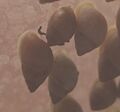 |
| Raiatean ground partula snail | Partula navigatoria | Raiatea, Society Islands, French Polynesia | The last known wild individuals were taken for a captive breeding program in 1992. The species was reintroduced in 2016. | |
| Tahitian Nodular Partula | Partula nodosa | Tahiti, Society Islands, French Polynesia | Not recorded in the wild since E. rosea was introduced in 1977. | |
| Pink Partula | Partula rosea | Huahine, Society Islands, French Polynesia | Not recorded in the wild since E. rosea was introduced in the early 1990s. |  |
| Sutural partula | Partula suturalis | Moorea, Society Islands, French Polynesia | Not recorded in the wild since E. rosea was introduced in 1977. |  |
| Mount Tohiea Tree Snail | Partula tohiveana | Fareahito valley, Moorea, French Polynesia | Not recorded in the wild since E. rosea was introduced in 1977. | 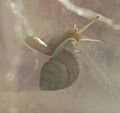 |
| Mourning Partula | Partula tristis | Raiatea, French Polynesia | Last recorded in the wild in 1992 as a result of predation by E. rosea. | |
| Variable Tree Snail | Partula varia | Huahine, Society Islands, French Polynesia | Not recorded in the wild since E. rosea was introduced in the early 1990s. A reintroduction attempt began in 2018. | 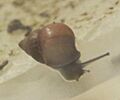 |
Plants (kingdom Plantae)
Order Arecales
Palm trees (family Arecaceae)
Order Fabales
Legumes (family Fabaceae)
Extinct in the wild
| Common name | Scientific name | Range | Comments | Pictures |
|---|---|---|---|---|
| Toromiro | Sophora toromiro | Easter Island, Chile | Last wild tree was cut down in 1960. Survives in captivity in Chile and other countries, but all attempts at reintroduction have been unsuccessful. |  |
See also
- Lists of extinct species
- List of Australia-New Guinea species extinct in the Holocene
- List of Hawaiian animals extinct in the Holocene
- List of New Zealand species extinct in the Holocene
- List of extinct bird species since 1500
- Extinct in the wild
- Lazarus taxon
- United States Fish and Wildlife Service
- IUCN Red List


